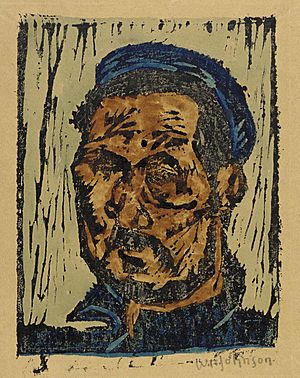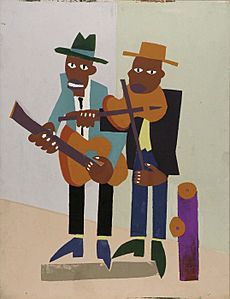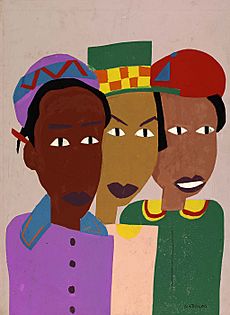William Johnson (artist) facts for kids
Quick facts for kids
William H. Johnson
|
|
|---|---|

Self-portrait, c. 1930–1945
|
|
| Born |
William Henry Johnson
March 18, 1901 |
| Died | April 13, 1970 (aged 69) |
| Nationality | American |
| Spouse(s) | Holcha Krake |
| Awards | Harmon Foundation Gold Medal for Excellence in Fine Arts |
| Patron(s) | Charles Hawthorne |
William Henry Johnson (born March 18, 1901 – died April 13, 1970) was an American painter. He was born in Florence, South Carolina.
Johnson became a student at the National Academy of Design in New York City. He later lived and worked in France, where he learned about modern art styles. After Johnson married Danish artist Holcha Krake, they lived in Scandinavia for some time. There, he was inspired by the strong folk art traditions.
The couple moved to the United States in 1938. Johnson found work as a teacher at the Harlem Community Art Center. This was part of the Federal Art Project, which helped artists during tough economic times.
Johnson's art style changed over his career. He started with realistic paintings, then moved to expressionism, and finally to a powerful folk style. This folk style is what he is most famous for today. Many of his paintings, watercolors, and prints are kept at the Smithsonian American Art Museum. This museum has also shown his works in big exhibitions.
Contents
Early Life and Art Education
William Henry Johnson was born on March 18, 1901, in Florence, South Carolina. His parents were Henry Johnson and Alice Smoot. He went to the Wilson School, which was the first public school for African Americans in Florence. It's thought that one of his teachers, Louise Fordham Holmes, taught him about drawing.
Johnson practiced drawing by copying comic strips from newspapers. He even thought about becoming a newspaper cartoonist. When he was 17, he moved from Florence to New York City. He worked many different jobs to save enough money for art classes.
He studied at the famous National Academy of Design. He took classes that focused on classical portrait painting and drawing people. Starting in 1923, Johnson studied with the painter Charles Webster Hawthorne. Hawthorne taught him how important color was in painting. Johnson studied with Hawthorne during the summers at the Cape Cod School of Art. He paid for his classes by working as a handyman at the school.
Johnson won several awards at the National Academy of Design. In his last year, he hoped to win a special scholarship to study abroad. When another student won it, his teacher Charles Hawthorne helped raise almost $1000. This money allowed Johnson to travel to Europe to continue his art studies.
Artistic Journey and Style
Johnson arrived in Paris, France, in the fall of 1927. He spent a year there and had his first art show in November 1927. He then moved to Cagnes-sur-Mer in southern France. There, he was inspired by the work of the expressionist painter Chaïm Soutine. In France, Johnson learned a lot about modernism, which was a new way of thinking about art.
During his time as an artist, Johnson used many different materials. He made woodcuts, oil paintings, watercolors, and drawings with pen and ink. He often used whatever art supplies he could find to create his work.
While in France, Johnson met Holcha Krake (April 6, 1885 – January 13, 1944). She was a Danish artist who worked with textiles. Holcha was traveling with her sister Erna, who was also a painter, and Erna's husband, the sculptor Christoph Voll. Johnson was invited to join them on a trip to Corsica. Johnson and Holcha became very close, even though they came from different backgrounds and had an age difference.
Johnson returned to the United States in 1929. Another artist, George Luks, encouraged Johnson to enter his art in a competition. This was for the William E. Harmon Foundation Award for Distinguished Achievement Among Negroes in the Fine Arts Field. Johnson won the Harmon gold medal for fine arts. People praised him as a "real modernist" and said his work was "spontaneous, vigorous, firm, direct." Other artists who won this award included Palmer Hayden and Laura Wheeler Waring.
While in the United States, Johnson also visited his family in Florence, South Carolina. He painted many new artworks there. He had two public art shows during this visit. One was at a meeting of teachers, and the other was at a local YMCA where his mother worked. His mother's boss helped him show 135 of his paintings for one afternoon. Even though a local newspaper described him in a simple way, it also said he had "real genius."
Johnson went back to Europe in 1930 by working on a cargo ship to France. He then went to Funen, an island in Denmark, to be with Holcha Krake. They got married a few days later in the town of Kerteminde. Johnson and his wife lived in Scandinavia for most of the 1930s. His interest in folk art grew during this time and influenced his paintings.
As Nazi ideas grew stronger in Germany and Europe in the late 1930s, many artists faced challenges. Johnson's brother-in-law, Christoph Voll, lost his teaching job, and his art was called "degenerate." Because of these dangers, Johnson and Krake decided to move to the United States in 1938.
After returning to the United States, Johnson's art changed a lot. Over the next ten years, his style became the strong, "primitivist" look he is known for today. These colorful and sometimes serious paintings showed the African-American experience from both a historical and personal point of view. This new style became very important for Johnson's work throughout the 1940s.
Johnson joined the WPA Federal Art Project. With help from Mary Beattie Brady, he found work as a teacher at the Harlem Community Art Center. There, he and other teachers taught about 600 students each week. This was part of a local Federal Art Project supported by the Works Progress Administration. Through the center, Johnson met important people from Harlem, like Henry Bannarn and Gwendolyn Knight.
He became deeply involved in African-American culture and traditions. He created paintings that had a simple folk art style. Johnson was determined to "paint his own people." He celebrated African American culture in city scenes like Street life - Harlem and Street Musicians. He also showed rural life in paintings like Farm Couple at Work and Sowing. He also painted about the harder parts of African American life, such as in Chain Gang. His painting Moon over Harlem was a response to community unrest in New York in 1943. He also created a series of works showing soldiers and nurses during wartime.
His paintings used striking and bright colors with simple figures. His art about African American culture often drew on his own childhood in the rural South. He also used religious and political ideas in his work. He wanted to show the richness of African culture and the modern ideas of the Harlem Renaissance.
In his Jitterbugs paintings, Johnson tried a new technique called screen printing. This allowed him to paint quickly and smoothly. He layered paint to create a rough and gritty look. Johnson used this technique to show the strength and endurance of his subjects. He had a solo art show at Alma Reed Galleries in 1941. Even though he had some success as an artist in the 1940s and 1950s, he never became financially stable.
The 1940s were a difficult time for Johnson personally. Sad news came from Europe. Christoph Voll, his brother-in-law, died in Germany after being questioned by Nazi officials. Holcha's family had to live through the German occupation of Denmark. In December 1942, Johnson and Krake moved to a bigger studio apartment. A week later, a fire destroyed Johnson's artwork, supplies, and personal items.
On January 13, 1944, Johnson's wife Holcha died from breast cancer. To cope with his sadness, he visited his family in Florence. He painted works with religious themes, like Mount Calvary. Mount Calvary and Booker T. Washington Legend were shown in an exhibition in 1945.
In 1946, Johnson traveled to Denmark to be with his wife's family. However, his behavior became more and more unusual. Johnson's sadness over his wife's death, along with his own health challenges, led to him needing medical care. As a U.S. citizen who was no longer considered able to make decisions for himself, he was sent back to New York. He entered the Central Islip State Hospital on Long Island in December 1947. He stayed there for the last twenty-three years of his life. He stopped painting after 1955 and passed away on April 13, 1970.
His life's work was bought in 1967 by the Smithsonian Institution's National Collection of Fine Arts (now the Smithsonian American Art Museum). This museum held his first major art show in 1971, shortly after he died.
Recognition and Legacy
In 1956, Johnson's life's work was almost lost. His caretaker said he could no longer pay for storage fees for his art. However, Helen Harriton, Mary Beattie Brady, and others arranged for Johnson's belongings to be given to the Harmon Foundation. This foundation would use his art to help people understand different cultures and support African American achievements in fine arts. On April 19, 1967, the Harmon Foundation gave more than 1,000 of Johnson's paintings, watercolors, and prints to the Smithsonian American Art Museum.
In 1991, the Smithsonian American Art Museum organized a big exhibition of his artwork called Homecoming: The Art and Life of William H. Johnson. In 2006, they organized another show called William H. Johnson's World on Paper. An even larger version of this exhibition traveled to other museums in 2007.
The William H. Johnson Foundation for the Arts was started in 2001. This was to honor William Johnson's 100th birthday. Since 2002, the Foundation has given the William H. Johnson Prize each year to a promising African American artist.
In 2012, the United States Postal Service honored Johnson by issuing a postage stamp. This recognized him as one of the most important African-American artists and a major figure in 20th-century American art. The stamp shows his painting Flowers (1939–40), which features brightly colored flowers on a small red table.
On March 18, 2020, the city of Florence, South Carolina, unveiled a statue to remember William Johnson. It is located in downtown Florence. The statue was created by sculptor Alex Palkovich. This statue was made to honor William, a local artist from Florence, and his contributions through his artwork that showed the beauty of his city.
Images for kids
See also
 In Spanish: William Johnson (artista) para niños
In Spanish: William Johnson (artista) para niños










